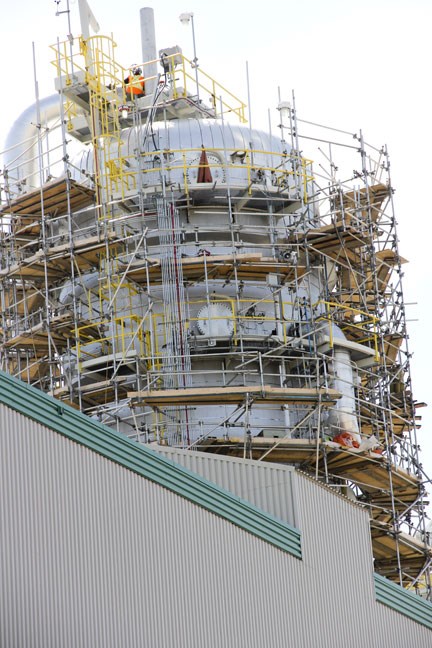International guests and media received their first glimpse into the innards of the Boundary Dam Carbon Capture Facility as the project ticks ever closer to its March 31, 2014 deadline.
Photography inside the carbon capture facility and the compressor building was strictly forbidden because of the proprietary technology inside, but the most striking thing about the interior is the complexity of the piping. The CCS facility has about 50,000 feet of pipe running through it, with even more decorating the inside of the compressor building.
Of course, the pipes aren't just for show. The enormous system is necessary for the complex flow of gases throughout the large chamber. It's not just carbon dioxide that is captured and produced. Mike Zeleny, SaskPower project manager, noted the carbon capture process also captures sulphur dioxide, which will then be turned into sulphuric acid and sold.
"We're going to sell that sulphuric acid on the market and make a bit of money on the byproduct," said Zeleny, noting it's one more way the carbon capture process can generate money, along with selling the captured carbon, which will go toward Cenovus' oil recovery projects near Weyburn.
The process removes 100 per cent of the SO2 and will generate about 60 tonnes of sulphuric acid per day.
Between 80 and 100 international guests attended the SaskPower Carbon Capture and Storage Information and Planning Symposium from May 21 to 23, which was hosted at Innovation Place in Regina and included a tour of the construction at Boundary Dam on May 22.
Carbon capture experts from China, Norway, Australia and other countries turned out to see exactly how things were going to work in a coal plant at the scale SaskPower is working with.
Inside the carbon capture facility, there will be two parallel processes, with the SO2 process on one side and the CO2 process on the other.
Zeleny said the flue gas comes from Unit 3 and enters in a flue gas cooler, because it must be cooled before it enters the SO2 absorber. That way the amine can complete its absorption work. From there, it goes out the top of the absorber, via a large silver duct, and enters a large fan that sucks the gas from the duct and the SO2 absorber, blowing it into the bottom of the CO2 absorber.
The final phase for the captured carbon will take the CO2 into the compressor building where moisture will be eliminated and the CO2 is compressed into a dense phase state. From there, most of it will be transported via pipeline to Cenovus Energy near Weyburn, while a small portion will be injected into the ground at the Petroleum Technology Research Centre's Aquistore site just west of the power station.
With carbon capture will come some loss in energy output from the refurbished stack.
He said the parasitic loss in energy production with the carbon capture facility will be a little more than 20 per cent. Boundary Dam Unit 3 will produce a total of 160 megawatts, but with the parasitic loss the net rating, or actual output, will be about 110 megawatts.
"As technology improves, with maybe better amines in the future or better technology to reduce the parasitic load, every improvement in the future is going to make a better business case for doing more of these," said Zeleny.
The new turbine will be more efficient, bringing the gross rating up to 160 from 150, and Zeleny said they will increase the steam temperature from 1,005 F to 1,050 F.
Zeleny said there are a few other countries that have been doing carbon capture on a smaller scale than at Boundary Dam Power Station. He noted there are projects in Norway and Wales, but those aren't equal to the size of SaskPower's.
"As far as commercially doing things, I'm not sure anyone's doing it in this fashion and at the scale that we are," said Zeleny. "It's wait and see, and when you get it running, we'll come and talk. A lot more people are understanding that we are serious and we're very close to getting this plant running and there's a lot more interest, almost by the week."
When international guests come in, Zeleny said what they ask most about is feasibility, and technical and economic viability.
"Those are the three keys."




